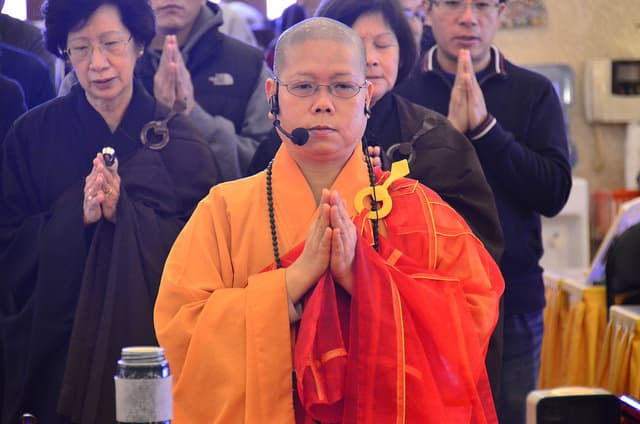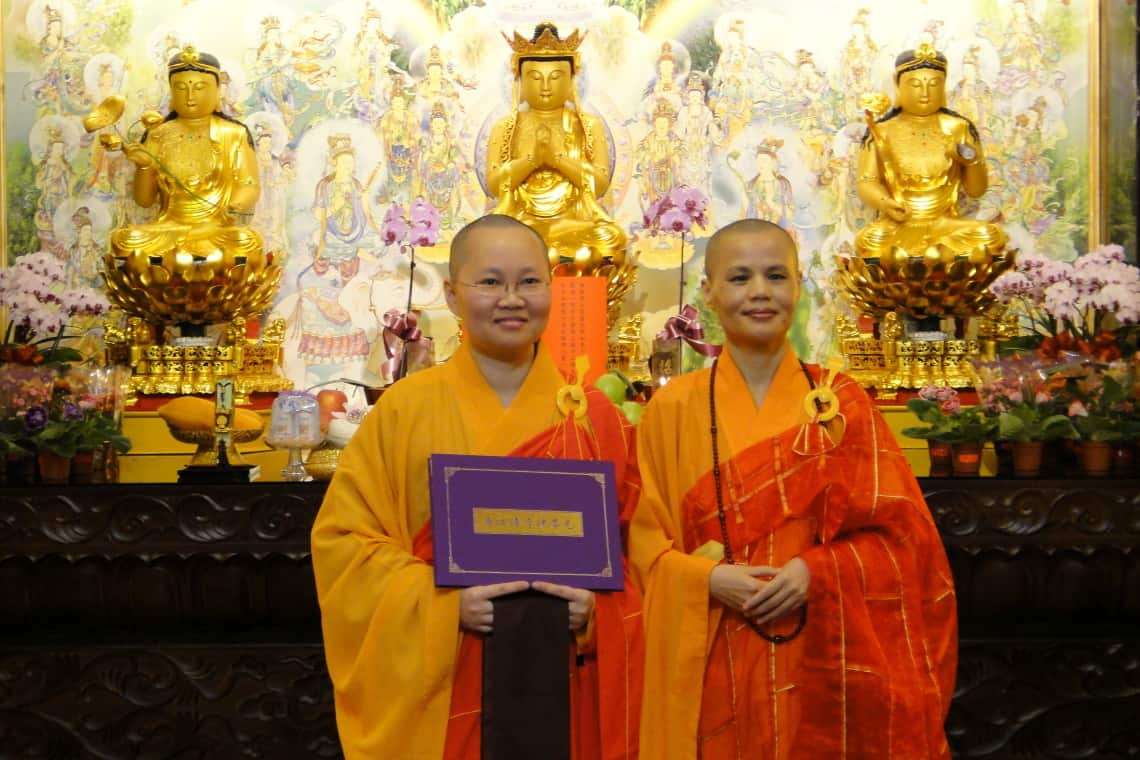第一任住持 成一和尚
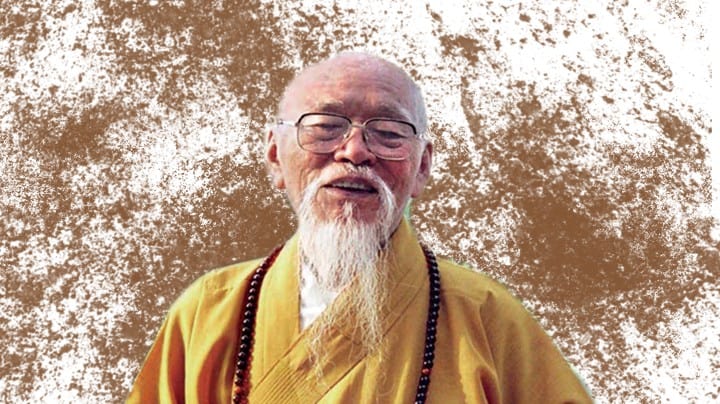
Ven. Master Chengyi, the clan of Qutang Town, Taixian County, Jiangsu Province, was born on February 28, 1914 in China with the surname Wang. He became a novice monastic at the age of 13, and went to study at Buddhist Institute of Guangxiao Temple.
In 1940, he ordained as a Buddhist Monk to undertake ascetic life. He passed the examination to enter Shanghai College of Traditional Chinese Medicine next year and graduated in 1947. During the period, he gave Buddhist teachings at the Jade Buddha Temple where he also opened a free Buddhist Clinic.
Because of the civil war in China, he moved to Taiwan in 1948 and committed to the circulation of Buddhist scriptures to Taiwan. Four years later (1952), he joined Ven. Master Nanting to found Huayen Lotus Society (HLS) in Taipei.
He also established Qiáo ài Buddhist Hall in 1962 and Chih-Kuang Vocational High School of Business & Technology in 1964. In I972, Ven. Master Chengyi became the Abbot of HLS. In 1975 he set up Hua-Yen Buddhist College (HYBC) and later in 1983, its graduate school, the Institute of Hua-Yen Buddhist Studies (IHBS) .
Since 1968, Ven. Master Chengyi was not only involved in Buddhist activities in Taiwan but also around the world. He attended international Buddhist conferences and received an honorary doctorate from USA Oriental University in 1984.
In December 1984 when Ven. Master Chengyi visited Bay Area in California to preach Buddhism, he promised the local Buddhists to build up a temple. The temporary Buddha Hall was set up in South Bay. The devotees have been gathering more and more gradually. In the autumn of 1986, a formal Buddha Hall was established in the same city. In August 1989, the board of directors of ABLS was founded, then purchased a land in Milpitas in the autumn. The construction took groundbreaking in 1990 and was completed in January 1992. In August 2004 an expansion project of ABLS kicked off and finished in September next year.
In 1988, Ven. Master Chengyi went back to Guangxiao Temple after 40-year separation of the Chinese Civil War. He worshiped the ancestors and started to rebuild the temple. The construction was finished in 1996 and then the Buddhist Institute reopened.
Ven. Master Chengyi devoted himself much to propagate Huayen theories. Besides the routine ceremonies held in Huayen Lotus Society, he gave Huayen courses in Lianhua Buddhist club of Yongming Temple and THBC. Ven. Mater Chengyi taught the meaning of Avatamsaka Sutru in public monastic ceremonies. His lectures were continuously published in Ten Thousand Journey magazine. He also has a long list of publications on his study of Huayen school.
When he was in charge of Huayen Lotus Society, he emphasized on monastic education. He set up Huayen Buddhist College to focus on Huayen theoretical research. He enhanced HLS to become a temple of cultivation with education. He opened the enrollment of graduation for 10 monastic students every year. The system promoted the Buddhist monastic learning in Taiwan.
Ven. Master Chengyi retired from HLS in 1999 because of health condition. He went back to Guangxiao Temple where he became a monk in 2010 and passed away the following year at the age of 98.
成一和尚,江蘇泰縣東鄉人氏(係現海安縣孫莊鎮),1914年農曆2月28日生,俗名王汝康,字仲義。父王正興,母孫氏,育有子女四人,和尚行二。和尚自幼十分懂事,3歲即能記事。6歲入私塾,7歲即讀完《三字經》、《百家姓》、《千字文》,並且涉獵《大學》、《中庸》及《論語》。後與其兄汝信考入韓氏私立小學,接受新式教育。兩年後完成高小課程。
13歲初中入學考,因病而無緣升學,痛苦之餘,忽憶10歲時算命先生告知11歲將有災難,因隨母長齋而無恙一事,遂發願出家修行。在堂房叔公王希國引薦下,該年農曆11月17日於同鄉營溪觀音禪寺禮春遠和尚出家,法號乘一(讀中醫學院時改名成一),名覺因,別號壽民。時觀音禪寺方丈為道如法師,有高足二人,一是文心,一是以心 (即智光大師),智老有徒南亭和尚,春遠即南老徒弟。出家為沙彌後,和尚從背誦〈華嚴發願文〉開始,五堂功課僅兩個多月就學習完成,之後即隨寺院法師從事經懺佛事。
1935年秋,任泰州光孝寺方丈的南亭和尚有感僧人學養的重要,修書觀音禪寺,要沙彌成一、果一隔年開春後赴光孝佛學院就讀。1936年2月,二人來到光孝寺佛學院,時佛學院分甲、乙兩班,成一進入乙班就讀,一週後轉入甲班。
1937年,中日戰爭爆發,南亭和尚不得不暫時將佛學院結束,但成一等一干沙彌學僧仍留光孝寺學習,智光老人亦避居寺中為學僧講課。1940年春,泰州局勢漸穩,佛學院恢復上課,成一任監學,並講授圭峰宗密之《原人論》。
1940年冬,徵得南亭和尚同意後,成一赴南京寶華山受具足戒,同行師門還有果一、宗一、圓一、妙然、守成等。戒畢,成一復回光孝寺繼續修學。
1941年,在師祖智光和尚的鼓勵下,成一赴上海考取「新中國醫學院」,後轉入「上海中醫學院」,前後學習六年,於1947年畢業。於上海學醫期間,在南亭和尚的介紹下,依止青蓮庵止方和尚,當止方和尚被聘為玉佛寺住持後,成公復隨往玉佛寺任佛學院教職,同時於寺中創辦佛教義診所。
1948年秋,上海局勢不穩,其佛學院業師張少齊(曾出家號爽亭,為同門師叔公)從南京至上海玉佛寺,要成一隨他同往臺灣,同年11月27日抵臺。落腳於臺北後,以臺灣佛經缺乏,勸請張老師成立「覺世圖書文具社」流通大陸佛經獲允。文具社先設於中華路,後遷至成都路,佛經流通工作直到1950年,因上海佛書無法運臺方才結束。
1949年5月,智光、南亭和尚來臺,成一迎住於臺北十普寺;1950年,南亭和尚移錫善導寺;1952年2月,南亭和尚於臺北市新生南路購建華嚴蓮社,召成一回蓮社;1959年正月,接任蓮社監院,以侍奉智老、南老二人。1962年,於桃園大溪創建僑愛講堂;1963年3月智老圓寂,成一思以辦學紀念先祖師;1964年8月,「智光商業職業學校」正式招生;1963年冬月,南亭將蓮社社務交予成一,監院由守成法師專任。翌年1964年4月4日,南亭和尚將光孝寺法脈傳予成一、妙然、守成三人,成一法名「瑞定」,為光孝寺法脈第十七代傳人,千華第卅七世;並續華嚴宗法為三十六傳,法名「聞虛」。
1972年3月1日,南亭和尚於華嚴月會上,正式將華嚴蓮社住持交給成一,自己宣佈退位。1975年8月,成一在南亭和尚指示下,創辦華嚴專宗學院,同年10月16日正式開學。1978年復開辦研究所。1982年9月,南老圓寂,成一接任智光商職董事長。
1968年起,成一和尚即膺任中國佛教會要職,活躍於國際佛教界。同年出席越南西貢召開之「世界佛教僧伽服務社會大會」;1970年,任中佛會東南亞訪問團副團長;1973年8月,率團參加韓國漢城所召開之「世界佛教青年領導訓練會議」;1980年7月,出席日本京都龍谷大學召開之「第三屆世界佛教學術會議」;1981年,出席在韓國召開之「第四屆世界佛教學術會議」;1984年5月,獲美國東方大學頒給榮譽博士學位;1986年,參加泰國曼谷佛光苑召開之「第四屆世界佛教徒僧伽會」;11月,率團參加在尼泊爾召開之「第十五屆世界佛教徒友誼會」;1987年8月,出席美國聖地牙哥召開之「中國哲學會議」;1988年10月,世界宗教徒協會成立,獲選副會長。
1984年12月,成一和尚應美國洛杉磯南灣區聖荷西市信眾前去弘法,並禮請到當地建寺。首先於南灣成立臨時佛堂,信徒慢慢增多後;1986年秋,購建另一大佛堂於同市;1989年8月,正式成立美國華嚴蓮社董事會,同年秋於南灣密爾必達市購地;1990年動土,1992年元月竣工;2004年8月,擴建美國華嚴蓮社;翌年2005年9月,華嚴蓮社擴建工程落成。
自1986年11月,成一和尚率團參加在尼泊爾召開之「第十五屆世界佛教徒友誼會」與大陸中國佛教協會會長趙樸初會面,開啟兩岸佛教界高層人士交流的先河,同時委託趙會長協助對祖庭光孝寺、觀音禪寺的重建。直到1987年政府終於開放了大陸探親。1988年9月,成一和尚回到睽違四十年的光孝寺,參訪、禮祖與安排接法傳人,隨即展開漫長的祖庭重建工程。1996年11月,光孝寺大殿重建落成並舉行開光典禮,其他殿宇也在幾年間陸續竣工,並恢復光孝寺佛學研究社,以便造就佛教人才,令正法流傳,宗門永續。
1994年起,即開始復建其出家道場營溪海安觀音禪寺,同年以其尊翁之名捐建「正興幼兒園」;1995年2月,復建觀音禪寺計劃獲地方政府通過,同年11月動土;1997年10月,觀音禪寺落成開光;2004年5月,觀音禪寺藏經樓落成啟用。
成一和尚在華嚴義學的弘傳方面,除了協助主持蓮社例行華嚴法會之外,自1979年起,於陽明山(永明寺)蓮華學佛園講授「華嚴要解」等課;1982年,南亭和尚圓寂後,成一和尚繼續主持《華嚴經》講座,為華嚴專宗學院學僧講《華嚴經》,自〈如來隨好光明功德品〉、〈普賢行願品〉、〈如來出現品〉、〈離世間品〉、〈入法界品〉到〈十地品〉,又於所屬分支道場宣講〈淨行品〉、〈普賢行願品〉、《華嚴發願文》、《華嚴綸貫》等;更每於華嚴共修會為信眾開示華嚴經文大意。長達十七年。1985年,美國華嚴蓮社創設後,還講過〈普賢行願品〉等華嚴短篇多種。並自1992年起,應邀至臺中沙鹿竹林禪寺講〈十地品〉連續三年,此〈十地品〉即蓮社所屬《萬行》雜誌連載迄今。成一在華嚴專論著作方面計有:《華嚴文選》、《如來隨好光明功德品講記》、《華嚴一乘淨土觀》、《華嚴發願文》、《華嚴綸貫略釋》、《華嚴經品會大意淺釋》、《華嚴發願文講記》、《華嚴佛七開示》等。
成一和尚主持華嚴蓮社,在教育事業上頗有成就者,乃是由其發起創辦於1975年10月的「華嚴專宗學院」,並出任院長,學院課程以華嚴大經為主修,其餘有助於華嚴經論義學的研究為輔。1983年,華嚴專宗學院增設研究所。1992年,蓮社由經懺道場改制為清修道場,並加強文化教育工作。1998年學年度,在都市道場不適合辦理叢林式僧團教育的前提下,改成每年招收十名研究生,對台灣佛學教育及僧才培育貢獻良多。
自1999年起,因為年齡及體力的關係,成一和尚卸下專宗學院院長一職,由賢度法師接任,隨即減少弘法活動,華嚴講座亦交賢度法師主持;但和尚持續關注蓮社社務,乃至研究所的教育動向等絲毫不減。2010年5月,完成智光、南亭二位祖師舍利回歸祖庭後,於光孝寺教導後進、頤養天年。2011年4月27日,示現微恙,以其多年專修彌勒淨土法門之功行,在全體法眷及信眾至誠稱彌勒聖號聲中安詳捨報於光孝寺,世壽98,僧臘85,戒臘72夏。荼毘後,部份舍利迎請回到美國華嚴蓮社永久供奉!
著作有:《慧日集》1─2─3集、《慧日集》新編、《成一文集》、《成一法語集》、《華嚴文選》、《華嚴綸貫略釋》、《出家三十要則講話》、《彌勒淨土法門集》、《環島弘法日記》、《為什麼要念佛》、《華嚴佛七開示錄》、《藥師佛七開示錄》、《華經品會大意淺釋》、《勸發菩提心講話》、《華嚴發願文講記》、《華嚴經如來隨好光明功德品講記》、《淨土法門集》、《華嚴經十地品講錄》(等待出版)、《中國藥用植物名實圖考》、《醫林學術時論集》等多種。
綜觀成公和尚少年出家、求學於大陸,青年弘法、辦學於臺灣,晚年重建祖庭、開啟兩岸交流,其功在佛教,弘法利生之偉業,足垂範後世矣。
第二任住持 淨海長老
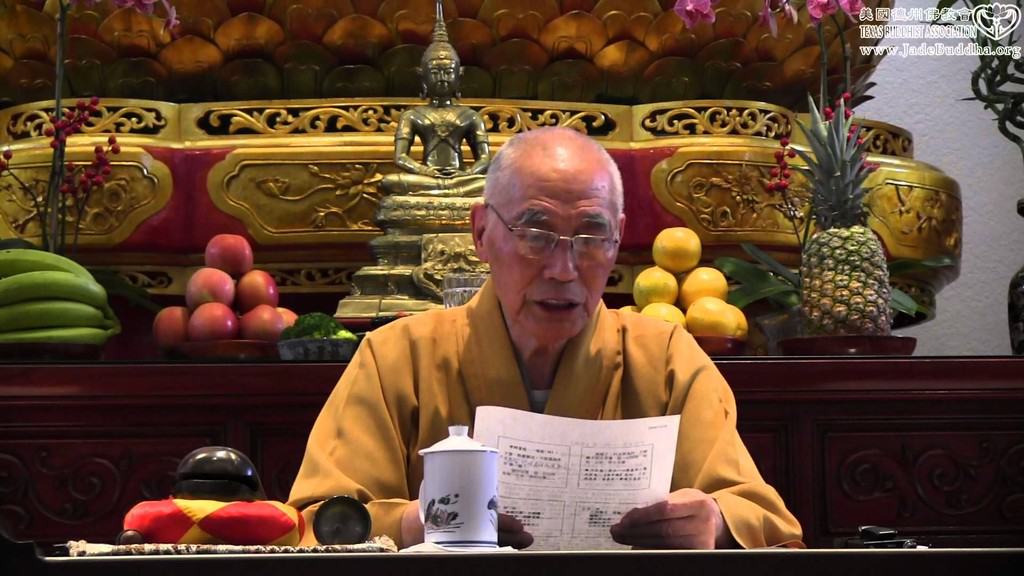
淨海長老出生於一九三一年,江蘇武進人,俗姓袁。九歲時在江蘇復興庵依止灼然法師出家。一九四六年在寶華山隆昌寺受具足戒。一九四七年常州天寧寺佛學院就讀。一九四九年赴臺灣,親近慈航法師,在台北汐止彌勒內院修學十年。一九六零年赴泰國攻讀泰文及巴利文,並進入朱拉隆功大學研究。一九六九年赴日本,東京立正大學研究,一九七一年獲得佛教學碩士學位。一九七二年前赴美國弘法,先後駐錫於紐約美國佛教會、報恩寺。一九七八年轉往美國南部休士頓市,與香港永惺法師合創德州佛教會佛光寺。一九八八至一九九四年間法師受聘擔任台北華嚴蓮社住持及同時擔任美國華嚴蓮社住持。
Ven. Elder Jin-Hai, surnamed Yuan, was born in Jiangsu, China in 1931. At the age of nine, he became a disciple monastic of Ven. Zhuo-Ran at Fu-Xing monastery and got the full ordination at Long-Chang Temple in Bao-Hua Mountain in 1946. In 1947, He went to study at Tian-Ning Temple Buddhist Collage in Chan-Zhou.
Ven. Elder Jing-Hai went to Taiwan in 1949 to learn from Ven. Ci-Hang and to study at Maitreya Inner Hall for ten years. In 1949, he went to Thailand for studying the languages of Thai and Pali and doing research at Chulalongkorn University.
In 1969, Ven. Elder Jing-Hai went to Japan for research at Rissho University in Tokyo and received a Master degree in Buddhism in 1971.
In 1972, Ven. Elder Jing-Hai went to the United States to promote Dharma and was stationed in The Buddhist Association of the United States (BAUS) and Bao-En Temple. In 1978, he moved to Houston and co-found Texas Buddhist Association – Buddha Light Temple with Ven. Yong-Xing of Hong Kong.
From 1988 to 1944, Ven. Elder Jing-Hai was appointed as the abbot of HLS and ABLS as the same time.
長老為了實現在美弘法的長遠理念,於二OO二年起和宏意法師共同推動美洲菩提中心的成立,希望佛教在美國的發展,是由外來的宗教而逐漸本土化,能夠落地生根,在美洲永遠傳承下去。
In order to realize the long-term goal of propagating Dharma in the United States, Ven. Elder Jing-Hai and Ven. Hung-Yi together promoted the establishment of American Bodhi Center in 2002. Their mission is to gradually localize Buddhism and forever growing in the United States.
淨海長老現任德州佛教會會長、德州佛教書院院長、《佛光法苑》雜誌發行人。對南傳佛教之介紹,不遺餘力,並著有《南傳佛教史》、《覺海觀覽》,翻譯作品有《真理的語言──法句經》、《佛陀畫傳》等書。
Ven. Elder Jin-Hai is currently president of Texas Buddhist Association (TBA), dean of Texas Buddhist Academy and polisher of TBA magazine. He spared no effort to introduce Theravada Buddhism and has authored two books, The History of Theravada Buddhism and The Sea of Enlightenment. He has also translated The Dhammapada (“The way of the Truth”) and A Pictorial Biography of Sakyamuni Buddha.
長老處世慈悲,待人寬厚,個性淡薄寧靜,隨緣盡份,以單純的心面對生命,坦率、以「直心是道場」,雖然早已屆退休之齡,但講經說法從未間斷,恆常地為佛法在美國的弘揚盡心盡力。
Ven. Jin-Hai is compassionate, generous and never asks much. With a gentle and quiet personality, he faces life straight forward by pure heart. Though he has reached his retirement age, he has never stopped preaching and propagating Dharma in the United States.
第三任住持 弘度法師
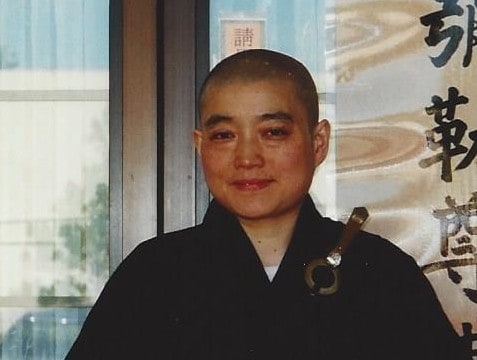
弘度法師,俗姓陳。1959年出生台灣,基隆市人。台灣基隆高級商業學校畢業。1987年華嚴專宗第三屆學生,1986年02月披剃於台北華嚴蓮社依止成公長老出家。
1986年夏天前往美國,協助成公長老處理社務及領眾共修。1989年05月出任美國華嚴蓮社監院。1994年初春弘度監院因病回台休養,半年後再度回美國,1995年接任住持,2001年07月功成退居。2012年12月中旬,回台定居。
Ven. Hong-Du, surnamed Chen from Keelung City, was born in Taiwan in 1959. He completed his studies in Taiwan National Keelung Commercial & Industrial Vocational Senior High School. He went to study in Huayen Academy in 1987 and became a disciple of Ven. Master Cheng-Yi of Taipei Huayen Lotus Society (HLS) in February 1986.
In the summer of 1986, Ven. Hong-Du went to the United States to assist Ven. Master Cheng Yi is general administration and leading public practices at ABLS. In May 1989, he was appointed as prior of ABLS. Ven. Hong-Du went back to Taiwan for medical leave in early 1994. He came again to the United States six months later and took over as abbot in 1995. Ven. Hong-Du retired in July 2001 and returned to settle in Taiwan in mid-December 2012.
第四任住持 賢度法師
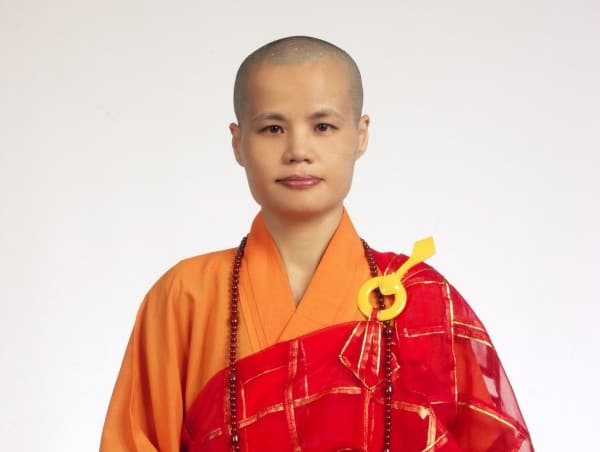
賢度法師,西元1960年生,祖籍江西會昌, 1986年禮上成下一老和尚出家,內號了行,別號思齊。1990年畢業於華嚴專宗學院佛學研究所; 2005年畢業於德里大學哲學博士。1994年接任台北華嚴蓮社第六任住持。2001年獲聘為華嚴蓮社副董事長。2009年任財團法人台北市華嚴蓮社董事長一職、中國佛教會理事、臺北市佛教會常務理事、美國華嚴蓮社董事長、2011年任智光商工職業學校董事長。2015年任常熟興福寺法界學院顧問。2016年獲聘擔任台北市政府民政局宗教事務諮詢委員會委員。2016年11月19日榮獲世界佛教傑出比丘尼貢獻表揚獎。
Ven. Hsiendu was born in 1960, her ancestral home in Huichang, Jiangxi province of China. In 1986 she was tonsured by Ven. Master Chengyi and given the Dharma name Liaoxing 了行, with the alternate name Siqi 思齊. In 1990 Ven. Hsiendu graduated from Hua-yen Institute of Buddhist Studies (HIBS) — the graduate school of the Taipei Huayen Buddhist College (THBC), and received her doctorate in philosophy from the University of Delhi in 2005. She served as the sixth abbess of Huayen Lotus Society (HLS) Taipei in 1994 and was appointed vice chairperson of the board in 2001. She held the posts as board chairperson of the Legal Foundation of HLS Taipei as well as the Avatamsaka Buddhist Lotus Society (ABLS) USA, director of Buddhist Association of the Republic of China, and executive director of the Buddhist Association of Taipei in 2009, and board chairperson of Chih-Kuang Vocational High School of Business and Technology in 2011. She served as an adviser of the Dharma Realm College of the Xingfu Temple at Changshu (Jiansu province) in 2015. She was appointed a member of the Advisory Committee on Religious Affairs in the Department of Civil Affairs of Taipei City Government in 2016. The same year she won the Global Outstanding Bhikkhuni Award on Nov. 19.
賢度法師專研華嚴經論及華嚴哲學思想,專修普賢行及法界觀,恆持準提法門為日課,並以華嚴行者為終身職志。華嚴蓮社在賢度法師魄力運作下,整修內外硬體,成立僧團,使蓮社成為一個擁有現代化設備,又不失傳統古風的弘修道場。提供僧信二眾一個更舒適的研習修學佛法的空間,並更落實興辦公益慈善及社會教化事業,秉持佛教慈、悲、喜、捨之精神,增進社會福祉,每年興資將蓮社百分之七十以上的收入,推動弘法、教育、文化、慈善四項志業不遺餘力,成果豐碩。其具體事蹟如下:
Ven. Hsiendu has specialized in the Avataṃsaka Sūtra and the Huayen literature and philosophy, focused on the Samantabhadra practice as well as the Contemplation of the Dharma Realm, and kept the Cundī practice on a daily basis. She has devoted her life to Huayen practices. In her effective management, HLS monastic community was established and both the interior and exterior of the building were remodeled. Now HLS has become a traditional Buddhist propagation and practice center with modernized facilities. It provides the monastic and lay assemblies with a better place to study and practice the Buddha’s teachings, and engages in charitable work and social edification with the Buddhist qualities of loving kindness, compassion, empathetic joy and equanimity in the hope of improving the welfare of society at large. Each year more than 70% of the money raised by HLS is spent on the four undertakings of Dharma propagation, education, culture and charity. Ven. Hsiendu’s all-out effort in these projects has brought about remarkably fruitful results. Her specific deeds are listed as follows.
1. 弘法
華嚴蓮社為臺灣少數以華嚴專修、專研、專弘的道場,其共修法會也表現出十足的華嚴特色,南亭和尚自1954年啟建每月兩次的華嚴誦經共修會,至今已長達63年不斷, 1957年啟建華嚴誦經法會分春秋二季,分誦《八十華嚴》上下各四十卷,年終舉行「華嚴佛七」。
1. Dharma Propagation
HLS is one of the few Taiwanese organizations which have been exclusively devoted to the study, practice and propagation of Huayen teachings. HLS Dharma services epitomize the Huayen tradition. It has been 63 years since Ven. Master Nanting started the semimonthly Huayen Sūtra Chanting Gathering in 1954. Starting from 1957 the Huayen Sūtra Chanting has been held in two seasons, with the first half of the Avataṃsaka Sūtra in eighty rolls recited in the spring service and the second half in autumn. The Seven-Day Huayen Buddha-recollection Retreat is held at the end of the year.
賢度法師1994年任住持以來除延續傳統外,2011年起舉辦準提懺共修會,又從2012年起,依北宋華嚴中興教祖晉水淨源大師編訂《華嚴普賢行願修證儀》舉行華嚴七處九會海印道場修證儀的模式擴大舉辦,於法會中設立華嚴七處九會海印壇場,舉行海印道場修證法會,帶領信眾依普賢行願懺儀觀修,在諷誦《華嚴經》的同時,隨文思義,深入了解法界真理,既保存傳統,又有現代創新的風格。
Ven. Hsiendu has continued this tradition since she served as HLS abbess in 1994. Moreover, she started the group practice of Cundī Repentance in 2011. Since 2012 she has also organized the Ocean-seal Bodhimaṇḍa Cultivation Dharma Service, an expanded ceremony in accordance with the Huayen Ritual Manual for Cultivating the Practice of Samantabhadra’s Vows by the northern Song master Jinshui Jingyuan, generally known as “Huayen Revival Patriarch”. Erected in this ritual is the Ocean-seal Shrine of Huayen’s Nine Assemblies at Seven Locations, in which the participants are led in contemplation and cultivation according to the Repentance Ritual of Samantabhadra’s Vows and Practices, so that they could think about the Buddha’s teachings while reciting the Avataṃsaka Sūtra and penetrate the reality of the dharma realm. This dharma service preserves traditions in a modern and innovative way.
面對氣候極端變遷,2016年於華嚴誦經會中以《華嚴經》與三世間關懷的連結為僧信二眾開示三世間自在的全體效應,從自身、人際、社會的安定與和諧,乃至擴大到外在世界的山河大地,即是情與無情同圓種智的不思議解脫境界!結合現代科技,科學知識推廣《華嚴經》是當今全球化趨勢下最契機的實踐哲學!2016年回顧蓮社臨濟禪宗法脈傳承祖師玉成尊宿的生平,舉行一日禪開示臨濟禪法。
In response to extreme climate change, Ven. Hsiendu expounded to monastic and lay participants in the 2016 Huayen Sūtra Chanting the connection between the Avataṃsaka Sūtra and the concern about the three realms of physical world, sentient beings and the enlightened, and pointed out the overall effect of freedom in these three realms. It was hoped that stability and harmony in each individual, interpersonal relationship and society could be extended to the entire external world, thus manifesting the inconceivably liberated state where the potentiality for perfect enlightenment is found in the sentient and insentient alike. Modern science and technology have been adopted to promote the teachings of the Avataṃsaka Sūtra, the most appropriate practical philosophy in the contemporary trend towards globalization. In the one-day meditation retreat held in 2016, Ven. Hsiendu reviewed the life of Ven. Master Yucheng, one of the Huayen masters in contemporary Chinese history as well as a Linji lineage holder, and elucidated the Linji Chan method.
1950年起南亭和尚於民本電臺開啟台灣第一次的空中弘法,後由賢度法師續講華嚴經,至今68年不斷。2001年起賢度法師從事電視弘法《華嚴經》講座課程,製作空中佛學院節目,對廣大媒體信眾播放,至今長達17年。
It has been more than sixty years since Ven. Master Nanting gave Dharma talks on Ming Pen Broadcasting Station in 1950, the very first on-air Dharma propagation in Taiwan, and Ven. Hsiendu has continued this task by expounding the Avataṃsaka Sūtra on radio. Starting from 2001, Ven. Hsiendu began the television lecture course on the same sūtra, a Buddhist TV series broadcast to the general followers to this day.
在2001至2018年間,為了要推廣華嚴教學,因早期的資訊不發達,凡接到講授華嚴邀請,都自己準備電腦及投影設備,前往世界各地進行華嚴專題講座多達76次,如:江蘇泰州光孝寺、泰州光孝佛學研究社、海安觀音禪寺、上海玉佛寺佛學院、江西金山寺尼眾佛學院、九華山佛學院、閩南佛學院、杭州佛學院、揚州法海寺、蘇州西園戒幢律寺、山東湛山學院、上海玉佛寺、華藏寺、濟南神通寺、常熟法界學院、安徽九華山翠峰寺、中國佛學院、中國佛學院棲霞山分院、中國佛教文化研究所、北京大學宗教學系及哲學系、復旦大學哲學系、山東大學哲學系。
Moreover, between 2001 and 2018, in order to promote Huayen studies, she traveled as many as 76 times all around the world as the invited seminar speaker, carrying her own computer and projector for the lectures, even in the days when information technology was less advanced. She gave talks at various places in Mainland China, such as the Guangxiao Monastery at Taizhou (Jiansu province) as well as its Buddhist Seminary, the Hai-an Guanyin Temple, the Shanghai Jade Buddha Temple as well as its Buddhist College, the Buddhist College of Jinshan Temple (Jiangxi province), the Mount Jiuhua Buddha College, the Buddhist College of Min-nan, the Hangzhou Buddhist College, the Fahai Temple at Yangzhou, the Xiyuan Jiechuang Temple at Suzhou, the Zhanshan Buddhist College (Shandong province), the Huazang Temple, the Shentong Temple at Jinan, the Dharma Realm College at Changshu, the Cuifeng Temple on Mount Jiuhua (Anhui province), the Buddhist Academy of China and its branch at Qixia Temple in Nanjing, the Institute of Buddhist Culture of China, the Department of Philosophy and Religious Studies at Peking University, the School of Philosophy at Fudan University and Philosophy Department at Shandong University.
歐美地區專題講座:美國加州華嚴蓮社、美國聞思修居士林、美國菩提學會、加州華僑相助會、美國Time時報True Family Values、華嚴佛學經論講座、華嚴論文研討會、奧地利維也納佛學中心、匈牙利佛學中心、聖荷西市議會等。東南亞地區華嚴經專題講座:馬來西亞檳城大山腳琉璃精舍、新加坡佛教會、馬來西亞佛學院、佛教總會等。
She participated in seminars held in Europe and USA by the following organizations: ABLS-USA, the Bodhi Way Association, the Mahabodhi Society of USA, the Chinese-American Mutual Assistance Association, True Family Values (sponsored by Time), the Vienna Buddhist Center in Austria, the Hungary Buddhist Center, San Jose City Council, etc. She also attended the Huayen Symposium and the Conference on Huayen Buddhism. The Southeast Asian seminar organizers who invited her to give presentations on Huayen Buddhism include the Vaidurya Buddhist Lodge at Bukit Mertajam in Penang, Malaysia, the Singapore Buddhist Association, the Malaysian Buddhist Institute, the Malaysian Buddhist Association, etc.
2. 教育事業
(1) 社會教育
2011年任智光商工職業學校董事長,開設:資料處理、資訊管理、餐飲管理、觀光事業、多媒體設計、電子、機械、演藝等共八科,目前學生總人數為三千人,學生參加全國工商業類科學生技藝競賽,至今榮獲86座金手獎及111項優勝,其中第一至三名共計有39座。經教育部評鑑為全國優質高級職業學校。
2. Education
(1) Social Education
In 2011 Ven. Hsiendu served as board chairperson of Chih-Kuang Vocational High School of Business and Technology, consisting of eight academic divisions: Data Processing, Information Management, Restaurant Management, Tourism Industry, Multimedia Design, Electronic Engineering, Mechanical Engineering and Performing Art. The students amount to 3,000, and they have won in the National Student Technological and Commercial Skills Competition 86 Golden Hand Awards and 111 Merit Prizes, among which there are 39 first through third prizes. It has been assessed as a high-quality vocational school in the national evaluation by the Ministry of Education.
(2) 佛教僧伽教育
賢度法師自西元1999年接任華嚴專宗學院院長及研究所所長以來,為學僧及信眾講解華嚴經,至今長達18年。重新制定華嚴學程規劃,以專研、專修、專弘華嚴為教學方針:一、專研華嚴經典教義,啟發本具善根智慧,依信解行證之順序,成就一乘道果。二、專修普賢行願,以十度、四攝成就無量眾生,以清淨菩薩萬行因華,莊嚴華藏淨土。三、專弘經教典籍,投身華嚴教學工作,培育華嚴學人,永續佛種、慧命不斷。
(2) Buddhist Sangha Education
Ven. Hsiendu has taught the Avataṃsaka Sūtra since she took over the post as Dean of THBC and HIBS in 1999. She redesigned the curriculum, with the exclusive focus on the study, practice and propagation of Huayen Buddhism as the educational policy. There are three guidelines: (1) focusing on the study of teachings of the Huayen scriptures, developing one’s own innate virtuous roots and wisdom, going through the four stages of cultivation—faith, understanding, practice and realization, and realizing the One Vehicle path and its fruition; (2) focusing on Samantabhadra’s vows and practices, benefiting innumerable sentient beings with the ten perfections (of generosity, morality, forbearance, effort, concentration, wisdom, skillful means, aspiration, powers and knowledge) as well as the four means of social cohesion (i.e. generosity, kind words, helpfulness and equal recognition of the other person’s interest), and adorning the lotus-womb pure land with myriads of pure bodhisattva practices as the causal conditions; (3) focusing on the propagation of the Huayen literature and philosophy, and devoting oneself to Huayen teachings and the cultivation of Huayen scholars, so as to preserve the Buddha’s teachings and wisdom as long as possible.
至今已22屆共121位研究生完成三年研究所學程。2013年與華梵大學合作開設碩士學分班,認證華嚴專宗研究所學程規劃中的十二個學分,研究生四年內即可同時完成教育部認可的碩士學位。
There have been 22 graduating classes with 121 graduate students who have completed their three-year program at graduate school since the establishment of HIBS in 1983. A graduate credit program was offered jointly by HIBS and Huafan University in 2013. Those graduate students who successfully complete 12 credits of the accredited HIBS courses in this program could earn in four years their Master’s degree recognized by the Ministry of Education.
賢度法師重視運用現代科技設備培養高知識教學人才,發揮道場弘化的最大功能,以達醒世利人的意義。隨著資訊時代的來臨,賢度法師在海內外弘法時,活用電腦多媒體教材,引導學僧及信眾從華嚴基礎學理至專題研究深入了解華嚴。例如:《十度波羅蜜》、《大方廣佛華嚴經釋義》、《華嚴宗思想》、《華嚴念佛法門》、〈十地品〉、〈十行品〉、〈十迴向品〉、〈十無盡藏品〉、〈升兜率天宮品〉、〈兜率宮中偈讚品〉、《華嚴行者對目前社會所面臨的危機之看法》、《華嚴經中的數量和時間觀》、《十定品要義》、《平等因果位如來出現品》、《入法界品》、《華嚴字母》、《佛教的生命關懷》、《華嚴宗源流》、《華嚴經三十九品概要》、《慈悲道場懺法概述》、《Development of the Hua-yen sect》、《Inspiration from Hua-yen Sutra》、《華嚴經要義》、《華嚴學要義》、《大悲無礙的觀音法門》、《饒益有情的藥師法門》、《華嚴的世界觀》、《華嚴宗史略》、《華嚴經對生命的啟示》、《探索婆羅浮屠佛塔與華嚴經的連結》、《華嚴經與三世間關懷的連結》、《華嚴的宇宙觀》、《普賢行願之實踐》、《緣起甚深》等。
Ven. Hsiendu values modern technology in training intellectual Dharma teachers and thus enables the Buddhist organization to fully perform its edification function and achieve the purpose of enlightening and benefiting the world. With the advent of the Information Age, she has made good use of computers and multimedia teaching materials while teaching the Dharma both at home and abroad, so that students could be guided from the understanding of basic Huayen doctrines up to in-depth research on Huayen Buddhism. The multimedia teaching materials include:
-
The Origin and Development of the Huayen School華嚴宗源流
-
A Brief History of the Huayen School華嚴宗史略
-
Huayen Philosophy華嚴宗思想
-
An Overview of the 39 Chapters in the Avataṃsaka Sūtra華嚴經三十九品概要
-
Essentials of the Avataṃsaka Sūtra華嚴經要義
-
Essentials of the Huayen Studies華嚴學要義
-
Commentary on the Avataṃsaka Sūtra大方廣佛華嚴經釋義
-
The Chapter “Ten Stages” 十地品
-
The Chapter “Ten Practices” 十行品
-
The Chapter “Ten Dedications” 十迴向品
-
The Chapter “Ten Inexhaustible Treasuries” 十無盡藏品
-
The Chapter “Ascending to the Tuṣita Heaven” 升兜率天宮品
-
The Chapter “Praises in the Tuṣita Heaven” 兜率宮中偈讚品
-
The Chapter “Entering the Dharma Realm” 入法界品
-
Equality in Causes and Fruitions: the Chapter “Tathāgatas’ Appearances “ 平等因果位如來出現品
-
Essentials of the Chapter of Ten Concentrations十定品要義
-
Ten Perfections十度波羅蜜
-
Perspectives on Numbers and Time in the Avataṃsaka Sūtra華嚴經中的數量和時間觀
-
The Avataṃsaka Alphabet (Arapacana) 華嚴字母
-
Inspiration from the Huayen Sūtra華嚴經對生命的啟示
-
The Profound Conditioned Origination緣起甚深
-
Huayen World View華嚴的世界觀
-
Huayen Cosmology華嚴的宇宙觀
-
The Connection between the Avataṃsaka Sūtra and the Concern about the Three Realms華嚴經與三世間關懷的連結
-
Buddhist Caring for Life佛教的生命關懷
-
Huayen Practitioners’ Perspective on Current Social Crisis華嚴行者對目前社會所面臨的危機之看法
-
Exploring the Connection between Borobudur and the Avataṃsaka Sūtra探索婆羅浮屠佛塔與華嚴經的連結
-
The Practice of Samantabhadra’s Vows普賢行願之實踐
-
Huayen Buddha-recollection Method華嚴念佛法門
-
Introduction to the Repentance Ritual of Kindness and Compassion Bodhimaṇḍa慈悲道場懺法概述
-
Guanyin’s Practice Method of Great Compassion and Freedom from Hindrances大悲無礙的觀音法門
-
Medicine Buddha’s Practice Method of Acting for the Welfare of Sentient Beings饒益有情的藥師法門
(3) 佛學推廣教育
從2010年研究所增設「選修生」,接引各大專院校生,並成立推廣部以接引社會人士。2012年申辦台北市政府所辦理的「終身學習護照發行實施計畫」開設佛學與才藝課程,與社區成人終身學習結合。
2014年成立國際華嚴研究中心推廣學術研究,與海內外各大專院校學者進行學術交流,結合世界各地學有專精的華嚴專家、學者,及立志投入修行實踐的行者,有組織、有計畫地推展華嚴教學、研究與觀行,進行華嚴師資培育和教案教材研發,以及華嚴典籍翻譯等多項工作,讓華嚴成為二十一世紀顯學,並培養年輕一代的弘法、教育、研修人才。
2015年成立美國國際華嚴研究中心,與加州聖荷西州立大學人文藝術學院簽署校際合作推廣華嚴學,成立華嚴研修教育基金,舉辦中英雙語華嚴經論講座,進行弘法現代化推廣全球化。
(3) Buddhist Continuing Education
HIBS started Non-degree Learning Program as well as the School of Continuing Education in 2010, to admit university students and the general public. The Buddhist and Creative Arts courses were added to the community adult learning in 2012, under the Taipei City Government’s “Lifelong Learning Passport Project”.
The International Center for Avatamsaka Studies (ICAS) was established in 2014 to promote academic studies, engage in academic exchange with universities and colleges both at home and abroad, and link up with Huayen experts, scholars and practitioners around the world. The ICAS aims to systematically propagate the Huayen teachings, studies and contemplation, educate qualified teachers of Huayen Buddhism, research and develop Huayen teaching plans and materials, and translate Huayen canonical works. It is hoped that the Huayen Buddhism could become a prominent school in the 21st century with the successful training of young talent in Huayen studies, practice, education and propagation.
The ICAS-USA, founded in 2015, signed a cooperation agreement with the College of Humanities and the Arts at the San José State University in California to promote the Huayen studies. It has also established the Education Fund of Huayen Study and Practice and organized bilingual Huayen symposia, striving to promote the Dharma throughout the world in a modern way.
(4) 國際學術研討交流
2005年賢度法師率華嚴專宗學院研究生至北京中國佛教文化研究所,由楊曾文所長親自接待主持交流座談會,並至北京大學宗教學系與哲學系合辦,華嚴專宗學院學術發表會。2011年應邀參加新加坡管理大學絲路之旅研討會發表論文〈探索婆羅浮屠佛塔與華嚴經的連結〉。2013年於浙江龍泉崇仁寺參與「華嚴禪國際學術研討會」發表論文。
(4) International Academic Research and Exchange
Ven. Hsiendu led HIBS students to the Institute of Buddhist Culture of China in Beijing in 2005, to participate in a forum where the director Yang Tsen-wen gave a friendly reception and chaired the discussion in person. This HIBS team also went to the Department of Philosophy and Religious Studies at Peking University to attend the HIBS Academic Conference jointly organized by the said department. Ven. Hsiendu presented the paper entitled “Exploring the Connection between Borobudur and the Avataṃsaka Sūtra” in the Symposium on the Silk Road in 2011 at the invitation of the organizer the Singapore Management University. She also presented a paper in the International Huayen-Chan Symposium at the Chongren Temple in Longquan (Zhejiang province).
2014年華嚴專宗學院與浙江省社會科學院簽署合作協議共同建立學術交流的合作機制。2014年台北華嚴蓮社與江蘇常熟興福寺簽署合作備忘錄正式啟動兩岸教育學術合作。2015年協助復辦常熟興福寺法界學院並任顧問。2012-2017連續舉辦6屆華嚴專宗國際研討會,2013-2017年連續舉辦5屆國際青年華嚴論壇, 2015年祖庭江蘇海安觀音禪寺恢復廿周年舉行回顧論壇。2015年華嚴專宗學院與政治大學合辦東亞視域下的華嚴思想國際研討會。2016年北京大學宗教學系樓宇烈教授率北京大學宗教學系、哲學系師生來訪與華嚴專宗學院舉行學術交流座談會。2015-2016華嚴專宗學院與常熟興福寺法界學院連續合辦兩屆「百年華嚴 百城烟水」國際研討會。
THBC signed a cooperation agreement with the Zhejiang Academy of Social Sciences in 2014 to jointly establish a collaboration mechanism for academic exchange. The same year HLS signed a Memorandum of Understanding with the Xingfu Temple at Changshu (Jiansu province), formally launching the cross-strait educational and academic collaboration. The Xingfu Temple resumed the operation of the Dharma Realm College in 2015 with the assistance of Ven. Hsiendu as an adviser. THBC and the Dharma Realm College worked together in 2015 and 2016 to organize two consecutive international centennial conferences on Huayen Buddhism. THBC held six annual international Huayen conferences from 2012 through 2017, five international Huayen youth forums from 2013 through 2017, as well as the retrospective forum in 2015 in commemoration of the 20th anniversary of the restoration of HLS patriarchal temple, the Hai-an Guanyin Temple (Jiansu province). In 2015 THBC also co-hosted with National Chengchi University the International Conference on the Thoughts of Buddhāvataṃsaka in East Asia. The following year Prof. Lou Yulie, together with teachers and students of the Department of Philosophy and Religious Studies at Peking University, visited HLS in Taipei and attended a forum for the academic exchange with THBC.
3. 文化
賢度法師華嚴著作出版
(1)《華嚴學講義》、(2)《轉法輪集一》、(3)《轉法輪集二》、(4)《佛教的制度與儀軌》、(5)《觀音法門》、(6)《華嚴淨土思想與念佛法門》、(7)《華嚴學專題研究》、(8)《善財童子五十三參的故事》、(9)《華嚴經世主妙嚴品淺釋上冊》、(10)《華嚴經世主妙嚴品淺釋下冊》、(11)《華嚴經十地品淺釋上冊》、(12) 《華嚴經十地品淺釋下冊》、(13)《華嚴經講錄 一.世主妙嚴品》、(14)《華嚴經講錄 二.如來現相品、普賢三昧品》、(15)《華嚴經講錄 三.世界成就品、華藏世界品、毗盧遮那品》、(16)《華嚴經講錄 四.如來名號品、四聖諦品、光明覺品》、(17) 《華嚴經講錄 五.菩薩問明品、淨行品、賢首品》、(18)《華嚴經講錄 六.升須彌山頂品、須彌頂上偈讚品、十住品、梵行品》、(19)《華嚴經講錄 七.初發心功德品、明法品》、(20)《禪學講義》、(21) 《Development of the Hua-yen School During The Tang Dynasty》等。
3. Culture
Master Hsiendu’s bibliography includes :
-
Study Guide for Huayen Studies
-
Turning the Dharma Wheel, I & II
-
Buddhist Rules and Rituals
-
Guanyin Practice Methods
-
Pure Land Thoughts and Buddha-recollection Practice Methods in Huayen Buddhism
-
Research on Specific Topics of Huayen Buddhism
-
The Story of Sudhana’s Pilgrimage to 53 Spiritual Masters
-
A Brief Commentary on the Chapter of the Wondrous Adornments of the Worlds’ Rulers, Vol. I & II
-
A Brief Commentary on the Chapter of Ten Stages, Vol. I & II
-
Lectures on the Avataṃsaka Sūtra I: Chapter “The Wondrous Adornments of the Worlds’ Rulers”
-
Lectures on the Avataṃsaka Sūtra II: Chapters “The Buddha’s Manifestations” and “Samantabhadra’s Samādhi”
-
Lectures on the Avataṃsaka Sūtra III: Chapters “Formation of Worlds,” “The Lotus-Womb World” and “Vairocana”
-
Lectures on the Avataṃsaka Sūtra IV: Chapters “The Buddha’s Names,” “The Four Noble Truths” and “Awakening by Light”
-
Lectures on the Avataṃsaka Sūtra V: Chapters “Bodhisattvas Ask for Clarification,” “Pure Conduct” and “Worthy Leader”
-
Lectures on the Avataṃsaka Sūtra VI: Chapters “Ascending to the Peak of Mount Sumeru,” ”Praises on the Peak of Mount Sumeru,” “Ten Abodes” and “Holy Conduct”
-
Lectures on the Avataṃsaka Sūtra VII: Chapters “Merit of Initial Aspiration for Enlightenment” and “Clarifying Methods”
-
Study Guide for Buddhist Meditation
-
Development of the Huayen School During the Tang Dynasty
DVD影音出版
賢度法師華嚴經系列講座DVD: (1)世主妙嚴品,(2)如來現相品、普賢三昧品、世界成就品、華藏世界品、毘盧遮那品,(3)如來名號品、四聖諦品、光明覺品、菩薩問明品、淨行品,(4)賢首品、昇須彌山頂品、須彌頂上偈讚品、十住品、梵行品,(5)初發心功德品、明法品、昇夜摩天宮品、夜摩宮中偈讚品,(6)十行品,(7)十地品〈一〉歡喜地,(8)十地品〈二〉離垢地,(9)十地品〈三〉發光地,(10) 十地品〈四〉燄慧地,(11)十地品〈五〉難勝地,(12)十地品〈六〉現前地,(13)十地品〈七〉遠行地,(14)十地品〈八〉不動地,(15)華嚴宗源流,(16)華嚴經義講解,(17) 華嚴經對生命的啟示,(18)華嚴經與普賢法門之連結,(19)華嚴經的世界觀, (20)華嚴字母,(21)準提法門專題講座等。
Her lecture courses on the Avataṃsaka Sūtra and other topics of Huayen Buddhism are also available in DVD format, including :
-
The Chapter “Wondrous Adornments of the Worlds’ Rulers”
-
Chapters “The Buddha’s Manifestations,” “Samantabhadra’s Samādhi,” “Formation of Worlds,” “The Lotus-Womb World” and “Vairocana”
-
Chapters “The Buddha’s Names,” “The Four Noble Truths,” “Awakening by Light,” “Bodhisattvas Ask for Clarification” and “Pure Conduct”
-
Chapters “Worthy Leader,” “Ascending to the Peak of Mount Sumeru,” ”Praises on the Peak of Mount Sumeru,” “Ten Abodes” and “Holy Conduct”
-
Chapters “Merit of Initial Aspiration for Enlightenment,” “Clarifying Methods,” “Ascending to the Suyama Heaven Palace” and “Praises in the Suyama Heaven Palace”
-
The Chapter “Ten Practices”
-
The Chapter “Ten Stages” I: Joyous Stage
-
The Chapter “Ten Stages” II: Immaculate Stage
-
The Chapter “Ten Stages” III: Luminous Stage
-
The Chapter “Ten Stages” IV: Radiant Stage
-
The Chapter “Ten Stages” V: Invincible Stage
-
The Chapter “Ten Stages” VI: Manifestation Stage
-
The Chapter “Ten Stages” VII: Far-going Stage
-
The Chapter “Ten Stages” VIII: Immovable Stage
-
The Origin and Development of the Huayen School
-
Exposition of Huayen Doctrines
-
Inspiration from the Huayen Sūtra
-
Exploring the Connection between the Avataṃsaka Sūtra and Samantabhadra Practice Methods
-
The Huayen World View
-
The Avataṃsaka Alphabet
-
The Cundī Practice Seminar
其所著的《華嚴學講義》(簡體字版),2006年於大陸宗教文化出版社出版,現為中國大陸大專院校相關科系指定教科書。而對於中文傳法僅能囿於華人圈亦有所體悟,故特別禮聘專家進行《華嚴經》的英譯工作,亦是臺灣佛教緇素少數具此遠見者。
1996年成立叢書出版部,出版華嚴祖庭、華嚴學海、萬行叢書、成一和尚著作系列、大專青年獎學金論文集、華嚴多媒體教材系列,2001年出版新修華嚴疏鈔20冊。2010年起連續舉辦華嚴書畫、攝影、書籍、經書剪紙藝術展覽。2013年與法鼓大學數位典藏編輯教學合作,開設華嚴數位教學課程,編輯賢度法師華嚴著作集電子書13本、新修華嚴經疏鈔數位典藏。
2015年起為推廣華嚴教學,接引更多青年學子接觸佛教與《華嚴經》,特舉辦「華嚴金獅獎」,鼓勵高中職與大專院校在校學生,以微電影、散文、平面設計、書法與偈語創作、繪畫、攝影、音樂創作等形式,結合日常生活,展現《華嚴經》之豐富內涵深化佛教在社會的影響力。
The simplified Chinese edition of Ven. Hsiendu’s Study Guide for Huayen Studies, published by the Religion Culture Publishing House in Mainland China in 2006, is the core textbook assigned by relevant departments of Mainland China’s universities. Moreover, in view of the fact that Dharma teaching in Chinese is limited to Chinese communities, Ven. Hsiendu courteously invited specialists to translate the Avataṃsaka Sūtra into English, showing a foresight rare among Taiwan’s Buddhists.
The publishing department was established in 1996 to publish series of Huayen-related works, including the Huayen Patriarchs, the Huayen Studies, the All Ways, Venerable Master Chengyi’s Works, the Anthology of Essays by College Student Scholarship Recipients and Multimedia Teaching Materials of Huayen Buddhism. It also published the 20-volume New Revised and Enlarged Edition of Chengguan’s Commentary and Sub-commentary on the Avataṃsaka Sūtra in 2001. Since 2010 there have been exhibitions of Chinese calligraphy and painting, photography, books and sutra papercutting. In 2013, THBC collaborated with Dharma Drum Institute on the Digital Archives Project to jointly offer digital Huayen courses, produce 13 e-books from Ven. Hsiendu’s works, and create the digital archive of the said new edition of Chengguan’s commentaries.
In order to expose more young people to Buddhism and the Avataṃsaka Sūtra, the Huayen Golden Lion Award was established in 2015. Since then it has been bestowed upon senior high school, vocational school and college students who successfully integrate the Huayen teachings into daily life in the form of micro movie, prose, verse, graphic design, Chinese calligraphy, painting, photography or music composition. It is hoped that Buddhist teachings can influence society more deeply.
4. 慈善公益
華嚴蓮社慈善工作於1958年起為鼓勵青年學子親近佛教、研究佛學,設立大專佛學獎學金達59年。1960年起於各地對貧戶發放米糧、慰問金及寒衣,此等冬令救濟,慈善救濟之行57年不斷。現任董事長賢度法師對於慈善公益事業更不遺餘力,每年配合政府舉凡冬令救濟、慈幼扶孤、災難救濟等各項活動,竭力響應賑災濟貧,關懷弱勢。並加強各項服務分成養老、慈幼、扶孤、濟貧、救急、獎助學等項目,配合蓮社例行慈善公益事業,發揮佛教慈悲濟世的菩薩精神。每年均獲得內政部或台北市政府的肯定並表揚。2006年度至2015年度連續10年獲內政部表揚之「興辦公益慈善及社會教化事業績優事業團體」。
4. Charity and Public Welfare
It has been 60 years or so since HLS’s charitable work began with the establishment of the College Student Buddhist Studies Scholarship in 1958, in the hope of encouraging young people to understand and study Buddhism. HLS has also provided winter relief since 1960, offering needy families food, winter clothing and money. As board chairperson of HLS, Ven. Hsiendu has devoted herself to charity. She spares no effort to join the government relief efforts every year, including winter relief, caring for orphans and the disadvantaged, disaster relief, and so on. She has also organized and improved HLS charitable work to provide services for different groups, such as the elderly, children, orphans, the needy, victims of natural disasters or people in times of crisis, and students who need financial aids, which embodies Buddhist bodhisattvas’ compassion and altruistic spirit. HLS charitable work was recognized by the Ministry of Interior and the Taipei City Government with the annual award for the outstanding organization in charity, public welfare and social edification from 2006 through 2015.
賢度法師認為當今世界的亂象與日劇增佛法不能只是以苦、集、滅、道來解釋宇宙人生的真相,要用科學的角度去發掘大環境驟變的事實,及因應的準備,還要發願學習做人間的菩薩,過去太虛大師倡導「人間佛教」至今,講求以佛法自利、利他普度眾生,佛教徒也常常行弘法、慈善事業於人間,做了很久也很普及,而所謂的學習做人間的菩薩,是當你自己對人事物的不滿感到很苦,生起了出離心,對一個學習華嚴的人,要體認到人世間不可能找到任何能符合你的標準的人、事、物,因為我們本來就不是從這個世間來的,是帶者使命來改變這個世界的,要讓不好的人變好,不美的事物變美,不良善的人轉變成善根人,這不是消極的或隨緣的等待因緣的成熟。
Ven. Hsiendu believes that, to solve the worsening social problems in today’s world, we need to do more than explaining the truths about human life and the universe with unsatisfactoriness (Skt. duḥkha), its cause, its cessation and the path to its cessation. It is also necessary to explore the fact about drastic environmental changes from a scientific perspective, get prepared to cope with them, and aspire to be a bodhisattva practitioner in the human world. It is true that, since Master Taixu (1890–1947) advocated “Humanistic Buddhism,” which emphasizes benefiting self and others with the Buddha’s teachings, Buddhists have widely propagated the Buddhadharma and engaged in charitable work to this day. But for us who study and practice the Huayen teachings, as we learn to be a bodhisattva practitioner in the human world, we also need to realize that it is impossible to find anyone or anything that completely meets our standards when we aspire to renunciation as a result of dissatisfaction with someone or something. We have come to this world with the mission to transform it, turning evil to good, unwholesomeness to wholesomeness, unpleasantness to pleasantness, instead of passively waiting for the ripening of causes and conditions.
華嚴的性起即從佛性而起,一切法隨順其真實本性,應眾生之根機、能力而生起教化作用,佛性本來具足於眾生心中。釋迦牟尼佛到世間來只為一個大事因緣,開示悟入眾生成佛知見,所以這是每個人都應具備的能力,佛教徒應該有捨我其誰的精神,研究華嚴的人更應當仁不讓。不一定要修行成就了大菩薩才能做,方法就是:華嚴的學者、行者要發願做生命實踐,從悲智雙運實踐十波羅蜜:佈施、持戒、忍辱、精進、禪定、般若、方便、願、力、智,所得到的出世智慧與資糧成就無盡藏,要積極的發四無量心:慈、悲、喜、捨,方便善巧融合世間五明:聲明、因明、醫方明、工巧明、內明以四攝:佈施、愛語、利行、同事來方便救助、引導世人走出迷惘困頓,解決宇宙人生的問題,並且落實在弘法、教育、文化、慈善四大志業的工作中,佛教才能為普羅大眾所接受,才能達到利益眾生,改變世界的未來。這是賢度法師多年來專研華嚴的理念,為華嚴佛法於現代社會的弘傳與研究開闢出新的路徑。
The “nature origination” in Huayen philosophy refers to the arising from the buddha nature, which all sentient beings are innately endowed with. All phenomena arise from their true nature and each sentient being should be edified according to their own spiritual potential and capacity. Shakyamuni Buddha appeared in this world simply for the purpose of disclosing and indicating to sentient beings the Buddha’s knowledge and insight as well as helping them to realize and enter Buddhahood. Therefore, everyone has the potential to become a buddha. Buddhists, and those who study and practice the Huayen Buddhism in particular, should not wait until they reach the level of great bodhisattvas. Instead, they should proactively take the responsibility for the edification of the world by vowing to put the Dharma into practice in everyday life. To put it specifically, they need to put equal emphasis on compassion and wisdom in practicing the ten perfections of generosity, morality, forbearance, effort, concentration, wisdom, skillful means, aspiration, powers and knowledge, to attain the inexhaustible collection of supramundane wisdom and requisites. They also need to develop the four boundless qualities (i.e. loving kindness, compassion, empathetic joy and equanimity), make skillful use of the five sciences (i.e. grammar and linguistics, logic, medicine, manual arts, and knowledge of the Tripiṭaka and the twelve categories of the Buddha’s word), and adopt the four means of social cohesion (i.e. generosity, kind words, helpfulness, and equal recognition of the other person’s interest), so as to help people get out of delusion and solve their problems in their life and world. Only when these guidelines are followed in the four undertakings of Dharma propagation, education, culture and charity, will Buddhism be accepted by the general public, thus benefiting sentient beings and changing the world for the better. These are the principles derived from Ven. Hsiendu’s concentrated study of Huayen Buddhism; they show a new direction in Dharma propagation and study in the contemporary society.
第五任住持 慧道法師
慧道法師,原籍香港,早年畢業於香港理工大學,並獲取Degree of City and Guilds of London Institute,及後赴台灣專一研讀佛學,1997年畢業於台北華嚴專宗佛學院,2000年取得佛學研究所碩士文憑。曾任台北華嚴蓮社華嚴藏編纂會研究助理。
Ven. Hui-Dao, from Hong Kong, graduated from Hong Kong Polytechnic University and earned a degree of City and Guilds of London Institute in his early years. He went to Taiwan to study Buddhism and graduated from Hua-Yen Buddhist College (HYBC) in 1997. He earned a master degree in Buddhism in 2000 and served as research assistant of Huayen Codification Committee in Huayen Lotus Society (HLS).
2001年來美任職美國華嚴蓮社副寺,2007年接任住持任內帶動蓮社運作走向系統作業、制度化外,並對外弘揚華嚴教義,定期於「佛教聞思修居士林」開設華嚴導讀班。
Coming to the United States in 2001, Ven. Hui-Dao worked as the deputy abbot of ABLS. In 2007, he took over the abbot and led the operation of ABLS to be systematic and institutionalized. He propagated Huayen Buddhism to the public by giving general courses in Boddhi Way Assoiciation.
2001年法師即開始領眾薰修每週的共修會、佛誕法會、清明、盂蘭及年終三個大法會,並接洽各類佛事,與建築委員會跟進擴建南大道20號工程。經與建築師、工程師及營造商多次的會議、決定、調解,最終於2005年落成啓用。
Every year, Ven. Hui-Dao hosed four special ceremonies for Buddha’s birthday, Qingming清明, Ullambana and Year-End Blessings. He also led Recitation & Cultivation Assembly every week. In addition to Buddhist affairs, he worked with construction committee to expand No.20 building in South Main Street. The project was completed after numerous meetings, discussions, and negotiations with the architects, the engineers and the builder. No.20 building was put into use in 2005.
法師於2007年升任住持後,將南大道50號舊大樓維修翻新,於2009年落成,命名成「成一樓」以紀念成公長老創建道場的辛勞。並開設多種才藝班,如:彩畫班、書法班、烹飪班、養生素食班等,給予信徒多方興趣的調劑。另有不定期舉辦禪七及學佛營,法師並親自帶領準提營及藥師營。
In 2007, Ven. Hui-Dao was promoted to the abbot. He led the project to remodel the old building of No. 50. The construction was completed in 2009 and the building was renamed Chengyi Pavilion to commemorate Ven. Master Chengyi. Afterward, many courses have opened to the public, for example, painting class, calligraphy class, cooking class and vegan health class. The camps for Chan practice, Dharma learning were also held from time to time. Also, Ven. Hui-Dao personally led the camps of Cundī Dhāraṇī & Medicine Buddha.
由於科技發展一日千里,法師為配合現代化的經營管理,設立了美國華嚴蓮社的官方網站、FB 粉絲專頁,並將事務處文書作業電腦化。
To comply with contemporary high-tech, Ven. Hui-Dao set up internet home page, FaceBook acoount for ABLS and computerize the clerical work of the offices.
【ABLS 特別聲明】
美國華嚴蓮社第五任住持慧道 (天因)、前任當家會傑 (天融)、前任僧值寬清 (天寧) 三人,因涉嫌非法監聽,且未盡善良管理人之責任,侵損寺產,財務、稅務、帳務移交不清;欺辱護法信眾,使令身心受創;退失菩提道心,有違僧寶形象。種種欺師背祖、破壞僧倫之行為,經華嚴蓮社僧團羯磨后,決議擯出宗門,褫奪宗門法系人之名份,今後不得使用天字輩法名。
又,三人已於西元 2015 年 12 月 09 日傍晚,正式離開美國華嚴蓮社道場,並與華嚴蓮社僧團完全脫離關係。因此,三人在外之一切行為,一概與華嚴蓮社道場、華嚴宗門僧人無關。
美國華嚴蓮社,為一佛教正信道場。住持、當家的人事任用,是經董事會決議,由董事長代表聘任;餘常住執事,則是經華嚴蓮社僧團羯磨合議,由住持代表聘任。在美國合格律師的見證下,於董事會議上進行合法、正式的交接管理。
特此聲明
美國華嚴蓮社董事會 敬啟
第六任住持 天承法師
天承法師,華嚴法諱:悟融,臨濟別號:先果。台灣高雄市人。師承 上賢 下度上人。輔仁大學財經法律學系畢業後,立志專研、專修、專弘華嚴經教與普賢行願,於華嚴專宗研究所修業期滿,取得佛學碩士文憑;恆持準提法門及普賢觀行以為日課。因肯定《華嚴經》是成佛唯一的修學指南,也確定要透過行者自身的身心世界,於日常生活中實修及求證,遂以普賢行者作為盡未來際之職志。西元二O一三年,受法於恩師 上賢 下度法師,為南山律宗第三十九世、寶華山千華第二十六代、光孝堂上第十九代,華嚴宗第三十八傳、華嚴蓮社第五代,臨濟禪宗第五十四世、觀音禪寺第八代傳人。希冀承襲師傳法系宗風,悟證融容法界自在。
曾任台北華嚴蓮社賢度董事長行政助理、台北華嚴蓮社監院、美國華嚴蓮社董事、華嚴專宗研究所講師。現任美國華嚴蓮社第六任住持、美國國際華嚴研究中心副主任、華嚴專宗研究所講師,從事華嚴宗歷史、華嚴義學、準提法門之研修,以及華嚴學、華嚴宗、華嚴經教領域的佛教文化出版工作。曾負責《賢度法師華嚴著作集》數位化專案執行、《轉法輪集》系列叢書之改版編輯,發表〈《華嚴經》「異生世主」之生命實踐研究——以「主林神」為例〉、〈《華嚴經》「異生世主」之三學實踐研究——以「普遍吉祥無垢光夜神」為例〉、〈《修大方廣佛華嚴法界觀門》「理事無礙觀」之探究〉、〈從華嚴蓮社法脈淵源論近現代華嚴教學弘化之復興〉等學術論文。
天承法師遵循師父 賢度上人之職志,於美國華嚴蓮社常年推動弘法、教育、文化、慈善四大志業,同時在美國國際華嚴研究中心,進行華嚴教育研修的推廣,逐步培養大眾閱讀華嚴經論典籍的能力,帶動僧信二眾於生活中的日課修持,導入華嚴經教和觀行法門的修學與實踐;同時,加強校際間的合作交流,養成華嚴人才,接引有緣人共修福慧資糧,在地發揚華嚴法化中圓融和諧、智行合一的精神。
現職:美國華嚴蓮社副董事長、國際華嚴研究中心副主任、華嚴專宗研究所講師
地址:50 South Main Street, Milpitas CA 95035
電話:(408)942-0874
E-Mail:tiancheng@huayen.org.tw
A profile of Master Tian-Cheng
Ven. Tian-Cheng has greatly affirmed that the Avataṃsaka Sūtra is the only guidebook to achieve Buddhahood, and should be implemented and practiced in daily life and even throughout the whole life. Therefore, to fulfill Huayen Doctrine and Samantabhadra’s vows has become her lifelong commitment. In order to explore more about the discipline of Huayen Buddhism, she came to ask Master Hsien-Du to be her teacher and attained her master’s degree in Hua-yen Institute of Buddhist Studies, Taipei.
In 2013, she was certified by Master Hsien-Du as a successor of the 39th generation of the Vinaya school of the Southern Mountain lineage, the 38th Generation of the Huayen School, the 5th Generation of Hua-yen Lotus Society, and the 54th Generation of the Lin-Ji Chan School. Based on the tradition of the Vinaya School and the Huayen School, the Dharma name “Tian-Cheng” (天承) and the Buddhist courtesy name “Wu-Rong” (悟融) were given to her, respectively. She is expected to inherit (cheng) the traditions of these Buddhist schools and get to the realm of perfect harmony (rong) among all differences.
Ven. Tian-Cheng used to be Administrative Assistant to the chairman, Ven. Master Hsien-Du, of Huayen Lotus Society (HLS) Taipei; Prior of HLS; Director of Avatamsaka Buddhist Lotus Society (ABLS), and Lecturer of Hua-yen Institute of Buddhist Studies. She was in charge of the implementation of the digital project of The Collection of Venerable Hsien-Du’s Huayen works. She was revising editor of a series of books: The Collection of Turning the Dharma Wheel.
Her publications include the following monographs: “Life Practice of ‘Enlightened Pṛthag-jana’ in the Avatamsaka Sutra: Centering on ‘Forest-ruling Deities’;” “The Practice of Three Trainings of ‘Enlightened Pṛthag-jana’ in the Avatamsaka Sutra: Centering on ‘Night-ruling Deity Samantagaṃbhīraśrīvimalaprabhā’;” “An Inquiry into ‘Contemplation on the Non-Obstruction of Principle and Phenomena’ in Contemplation on the Huayen Dharmadhatu;” “Renaissance of Contemporary Huayen Teachings & Propagation: Perspectives of Huayen Lotus Society lineage.”
Ven. Tian-Cheng is currently the sixth abbot of Avatamsaka Buddhist Lotus Society (ABLS), deputy director of International Center for Avatamsaka Studies (ICAS-USA), and lecturer of Hua-yen Institute of Buddhist Studies (HIBS). She devotes herself in the study of Huayen School history, Huayen doctrine, Huayen practice, and the Dharma Gateway of the Cundī Dhāraṇī, as well as the publication of Buddhist literature & culture in the fields of Huayen Buddhism.
Following the steps of Master Hsien-Du, Ven. Tian-Cheng promotes four major Buddhist missions: Dharma propagation, Buddhist continuing education, culture & traditions preservation, and public welfare & charity. She also expands educational courses of International Center for Avatamsaka Studies (ICAS) for the public to enrich their understanding of Huayen Buddhism. The courses cover Chinese culture, Buddhist Sutras, Commentaries and Subcommentaries by Indian and Chinese Huayen Patriarchs. The classes help both renunciates and laymen to practice Huayen teachings in their daily lives.
At the same time, she actively works with other academic schools to develop Huayen teaching and research, to attract people pursuing cultivations on compassion and wisdom, and to spread the spirituality of Huayen Buddhism.
Education
June 2014 Master of Arts in Buddhist Studies
Hua-yen Institute of Buddhist Studies, Taipei
June 2000 Bachelor of Laws
Fu-Jen Catholic University, New Taipei
Current Position
Vice Chairperson, Avatamsaka Buddhist Lotus Society, U.S.A.
Vice Director, International Center for Avatamsaka Studies, U.S.A.
Lecturer, Hua-yen Institute of Buddhist Studies, Taipei
Work Experience
September 2015 – September 2023
Abbess, Avatamsaka Buddhist Lotus Society, U.S.A.
November 2014 – September 2015
Prior, Huayen Lotus Society, Taipei
July 2013 – October 2014
Executive Assistant to the President, Huayen Lotus Society, Taipei
March 2008 – February 2012
Huayen Studies Material Editor and Lecturer, Da Huayen Temple, New Taipei
May 2001 – February 2007
Prior, Ling Jiou Shan Wu-Sheng Monastery Taipei Dharma Hall, Taipei
July 2000 – April 2001
Executive Assistant, Ling Jiou Mountain Buddhist Society, Taipei
Ordination
April 05, 2013 Received Dharma Transmission of the Huayen School in Huayen Lotus Society, Taipei by Master Hsien-Du
October 10, 2003 Received Bhikkhuni Upasampada Ordination in Pao Hua Shan Lung-Chang Temple, Jiangsu, China
October 06, 2000 Tonsured and entered the Buddhist Monastic Order in Ling Jiou Shan Wu-Sheng Monastery, Taiwan by Master Hsin-Tao
第七任住持 天何法師
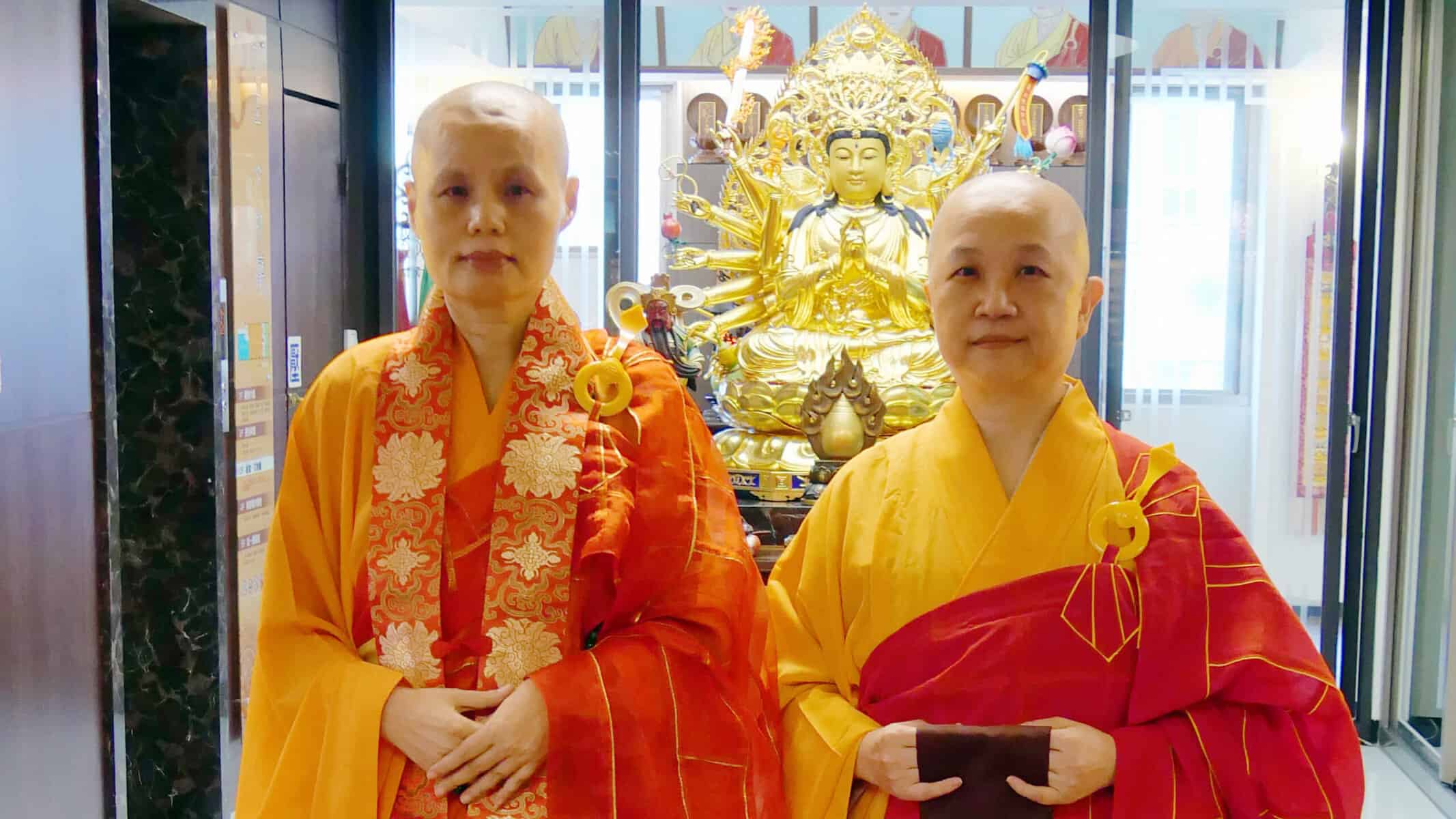
天何法師,華嚴法諱:悟妙。台灣台北市人。2003年投台灣高雄興隆淨寺住持上心下淳和尚尼座下剃度出家,法名:自觀,字號:見臻。2007年於高雄田寮日月禪寺完成三壇大戒。出家後奉師命修學華嚴,感受《華嚴經》像是一部行者的心靈修行地圖,能指引行者在疑惑時站穩腳步,不致迷失方向,又能引領行者走入聖道,帶真入俗,自修度眾無礙自在。惟願如善財童子,常隨善知識,學習菩薩行,實踐華嚴生命教育,直至圓滿普賢萬行。
南華大學宗教學研究所畢業後,為承華嚴之教法,得剃度恩師允許,敬向賢度和尚尼求法受記,為南山律宗第三十九世、寶華山千華第二十六代、光孝堂上第十九代、華嚴宗第三十八傳、華嚴蓮社第五代、臨濟禪宗第五十四世、觀音禪寺第八代傳人,希冀承襲宗風紹隆佛種,悟得解脫本不住,妙證菩薩非修來。
曾任:華嚴專宗大學部教務暨學務長、華嚴專宗大學部教師、僑愛佛教講堂推廣中心講師
現任:美國華嚴蓮社第七任住持、僑愛佛教講堂推廣中心講師
A profile of Master Tian He
Ven. Tian He, In 2003, was ordained under the abbot of Hsing Lung Ching Temple in Kaohsiung, Taiwan , Ven. Hsin Chun. Her ordination name is Zi Guan, and her courtesy name is Jian Zhen. In 2007, she completed the Triple Platform Ordination at Ri Yue Chan Temple in Tianliao, Kaohsiung.
After ordination, she followed her Master’s instructions to study the Hua Yan teachings. She feels that the Avatamsaka Sutra is like a spiritual map for practitioners, which can guide them to stand firm when in doubt, avoid losing direction, and lead them to the path of enlightenment. It can also help practitioners bring the truth into the mundane world and attain ease in self-cultivation and benefiting others. She aspires to follow the example of Shan Tsai in the sutra, always following good teachers, studying the bodhisattva path, and practicing Hua Yan’s philosophy of life education, until she fully embodies the spirit of Samantabhadra’s practice.
After graduating from the Graduate Institute of Religious Studies at Nanhua University, she was certified by Master Hsien-Du as a successor of the 39th generation of the Nanshan Vinaya School, the 26th generation of the Qianhua Baohua Mountain, the 19th generation of Guangxiao Temple, the 38th generation of the Hua Yen School, the fifth generation of the Hua Yen Lotus Society, the 54th generation of the Linji Chan School, and the eighth generation of the Guan Yin Chan Temple. Based on the tradition of the Vinaya School and Hua Yen School, the Buddhist name “Tian He”(天何) and the Buddhist courtesy name “Wu Miao”(悟妙) were given to her, respectively. She hopes to continue the tradition of the Buddha’s teachings and expected to perpetuate the wisdom-life of the Buddha and to ensure the continued prosperity of the Buddha-seed, even unto the day of Enlightenment.
Education
June 2013 Master of Arts in Religious Studies, the Graduate Institute of Religious Studies College of Humanities, NANHUA UNIVERSITY, Chiayi
Current Position
Abbess, Avatamsaka Buddhist Lotus Society, U.S.A.
Lecturer at the QiaoAi Buddhist Hall Promotion Center
Work Experience
Dean for Academic Affairs and Student Affairs at the Hua-Yen College
Teacher at the Hua-Yen College
Lecturer at the QiaoAi Buddhist Hall Promotion Center
Ordination
June 25, 2019 Received Dharma Transmission of the Hua-Yen School in Hua yen Loutus Society, Taipei by Master Hsien-Du
Nov. 25, 2007 Received Triple Platform Ordination in Ri Yue Chan Temple, Kaohsiung, Taiwan
Oct. 14, 2003 Tonsured and entered the buddhist monastic order in Hsing Lung Ching Temple , Taiwan by Master Hsin Chun

